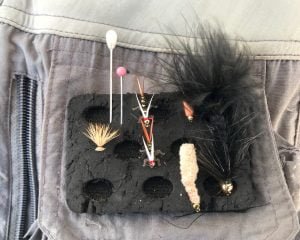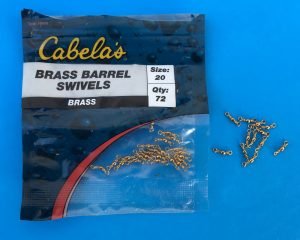Here’s a collection of tips that don’t fit into any category and will make your journey into the sport of fly fishing more straightforward – a few lessons from my personal school of hard knocks.
Problem: Sloppily tied flies with thread blocking the eye of the hook
Discussion: Mass-produced flies are inexpensive but the haste in which they are made sacrifices quality. Many times, the tier will loop thread over the eye of the hook; preventing insertion of tippet. While accessory manufacturers usually include a small pin on forceps or at the opposite end of nippers, they are awkward to use. Using the pin included on the Orvis forceps, it is easy to apply too much pressure when clearing out the thread and break the wire forming the eye of the hook. Of course, this usually happens on the last fly you have that is the hot pattern for the day. Nippers have a pin, but the flat surface of the tool is impossible to spin between two fingers to clear out thread. Finally, the pin on both implementations tends to be too thick and does not work on smaller hook sizes.
 Solution: Go raid the sewing cabinet and select a long pin – the kind that has a round plastic ball at the head. It is perfect to insert into the eye of the hook and easy to spin to grind out the thread. A sewing pin is narrower than the pin on some of the accessories, making it easier to insert in the hole. Carry different sizes in a fly box or on the fly patch of your vest.
Solution: Go raid the sewing cabinet and select a long pin – the kind that has a round plastic ball at the head. It is perfect to insert into the eye of the hook and easy to spin to grind out the thread. A sewing pin is narrower than the pin on some of the accessories, making it easier to insert in the hole. Carry different sizes in a fly box or on the fly patch of your vest.
Problem: Line droop
Discussion: If you have not been disciplined in keeping your floating fly line clean, accumulated dirt will eventually cause it to sink. While the solution is obvious – clean it – you probably will not have the capability to do that on the side of the stream when you discover the problem. Sometimes, applying paste floatant will restore buoyancy, but you may need to activate the nuclear option.
Solution: Grab an indicator and attach it onto the tippet where the tippet joins the fly line using an indicator just large enough to match the seriousness of the problem. The indicator should provide the necessary emergency buoyancy to keep the end of the fly line floating on the surface. The downside is the indicator will prevent the line from being fully retrieved onto the reel. If you are using a long tippet, you will need to deal with the stoppage when landing a fish. So, the best approach is to clean your fly line a few times each season.
Problem: Line twist
Discussion: When throwing heavy poppers or larger terrestrial flies, the current or the fly’s construction may cause it to roll, adding twist to the tippet. If you ever pulled your line out of the water and watched the fly spin at the end of the tippet, then you have experienced this problem.
 Solution: Here’s a crossover solution from spin fishing. Incorporate a small, size 20 barrel swivel onto your tippet. Swivels keep the blades on spinning lure from twisting the line and work the same for a
Solution: Here’s a crossover solution from spin fishing. Incorporate a small, size 20 barrel swivel onto your tippet. Swivels keep the blades on spinning lure from twisting the line and work the same for a
rolling fly. If you are worried about the swivel sinking and pulling the fly under the water, place it on the tippet where you would usually put an indicator. However, I found the size 20 swivel, being only 3/8 inch long, floats just fine and has never caused a problem.
